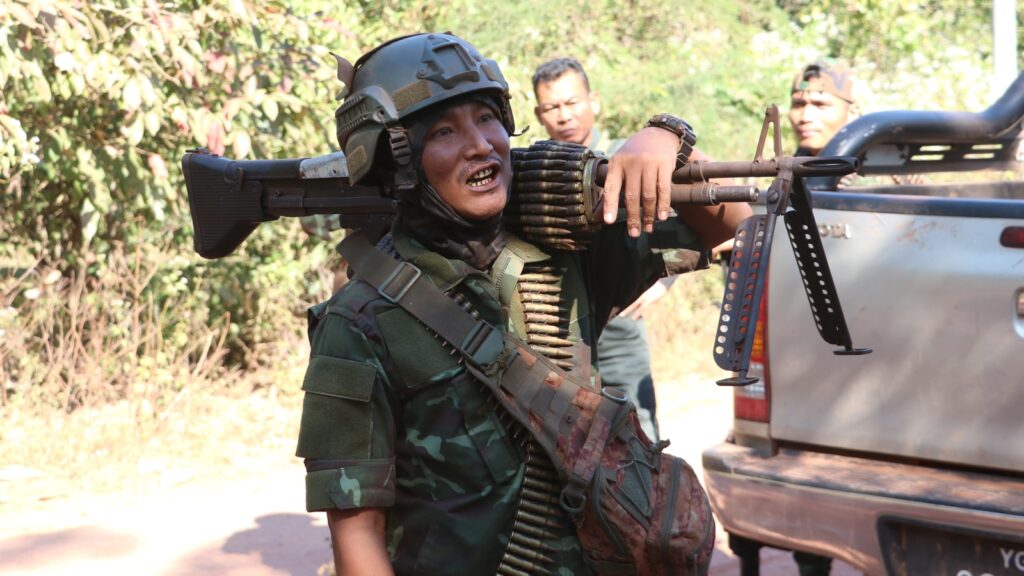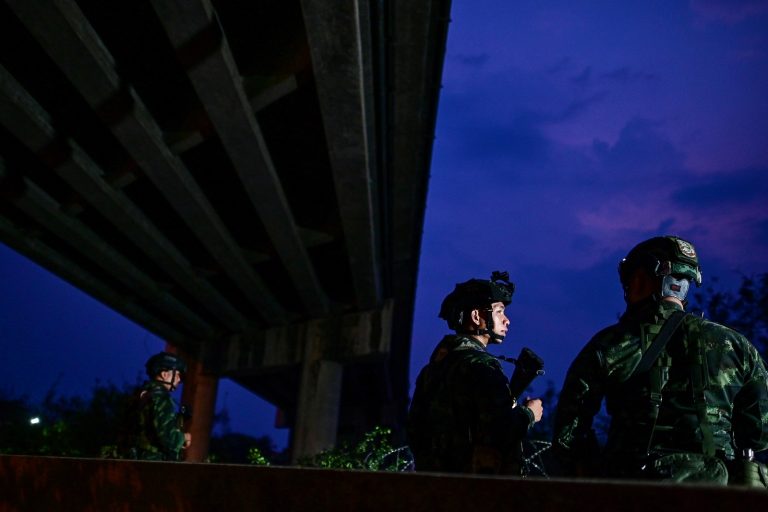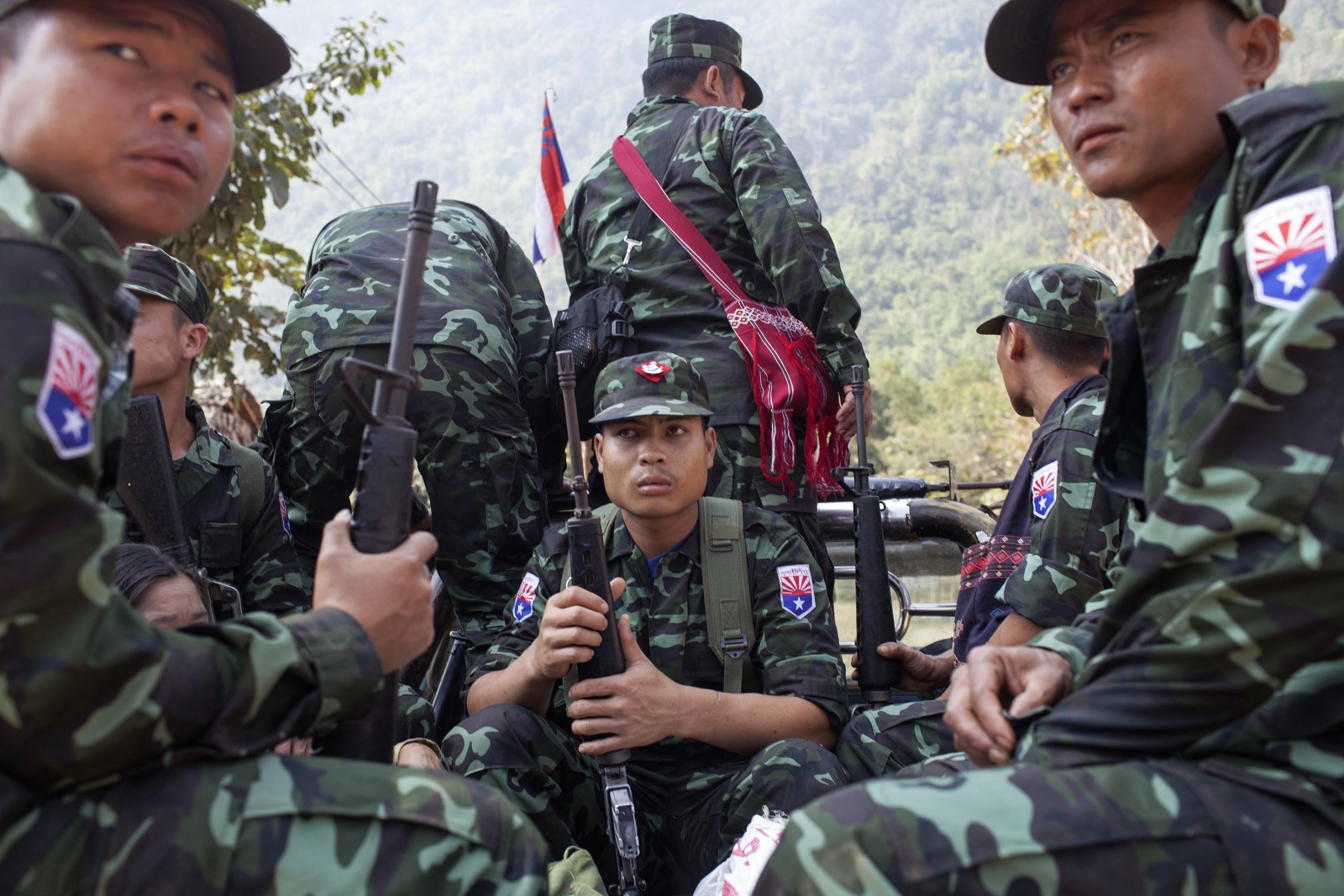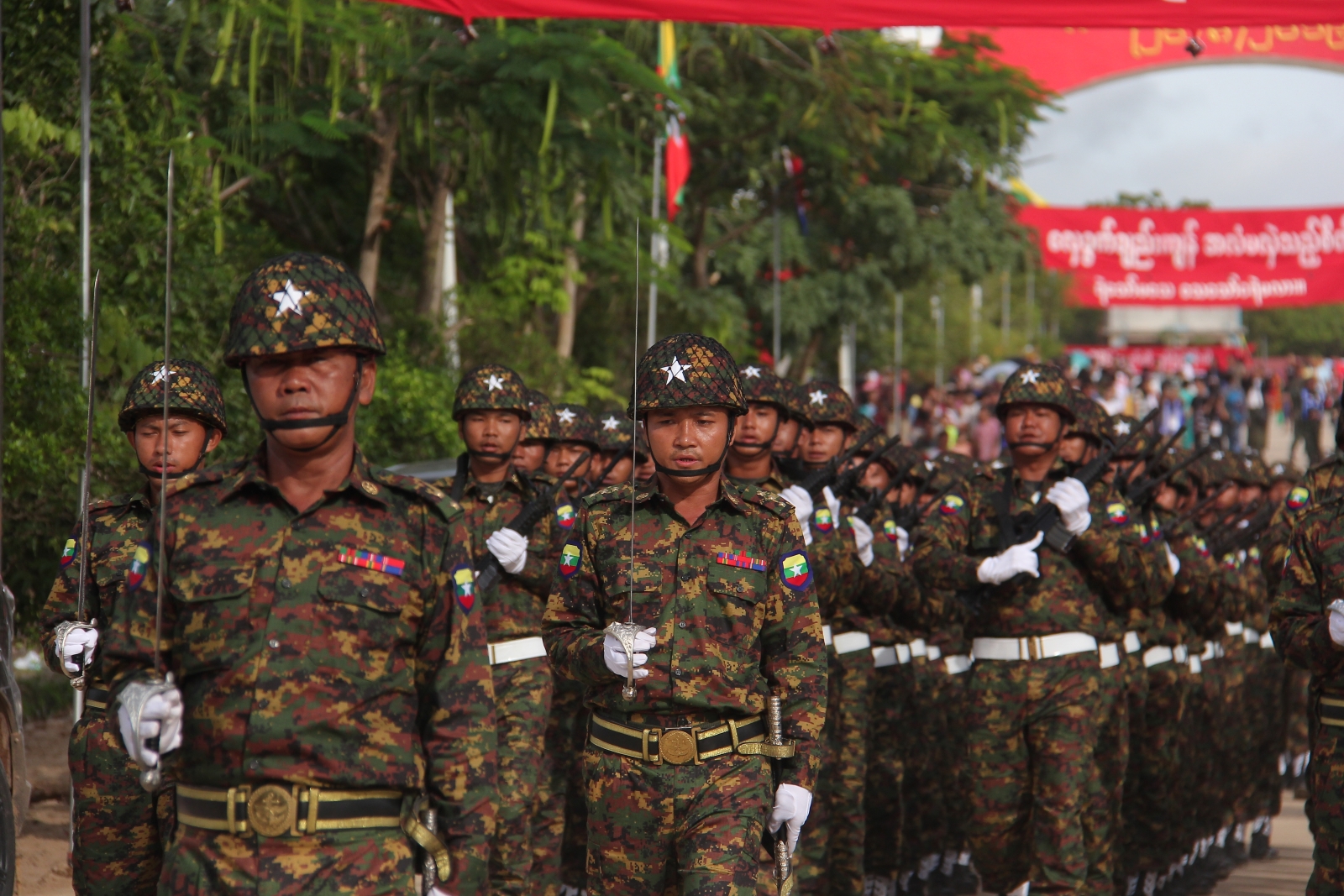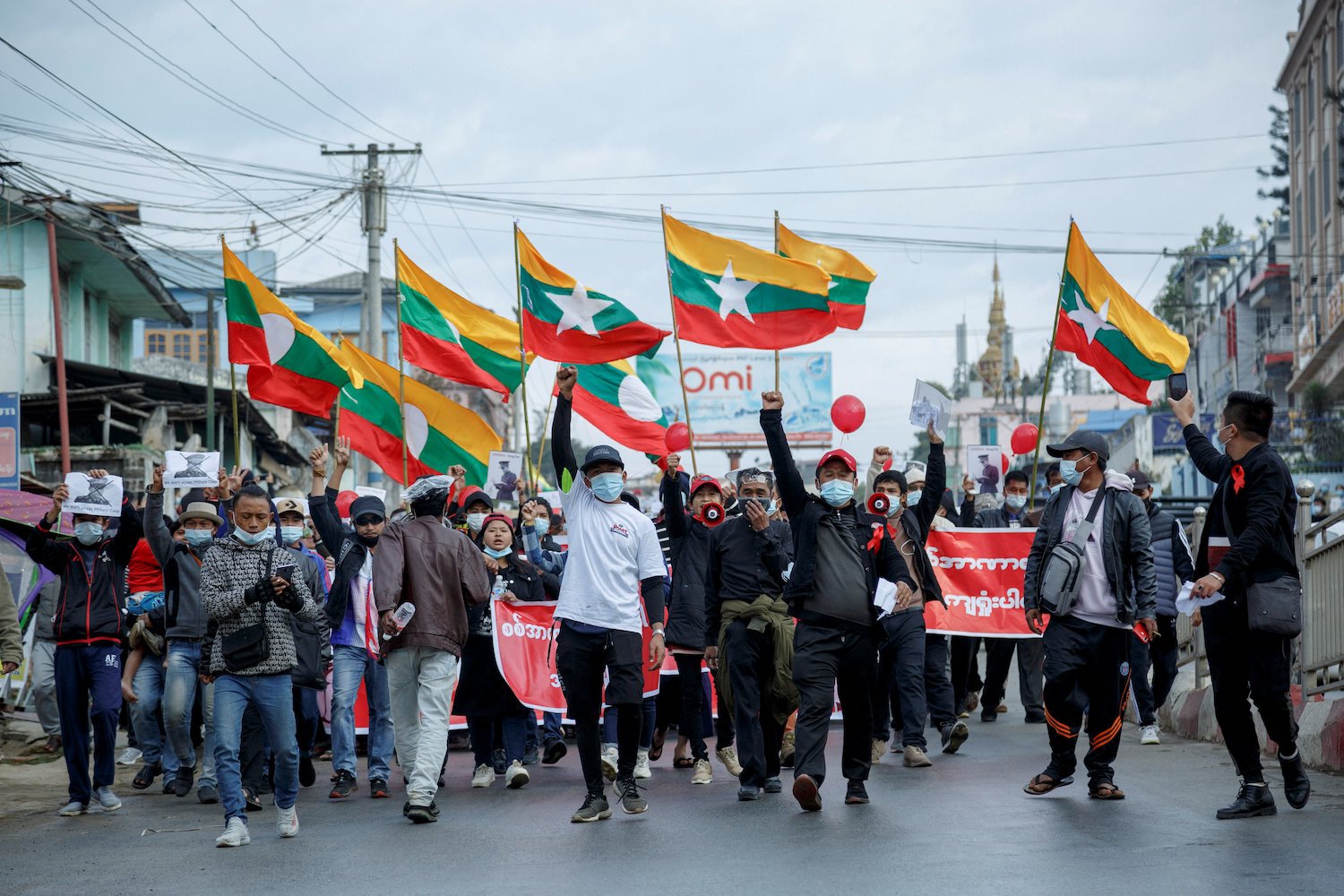Despite heavy fighting in Kawkareik, resistance groups insist they haven’t launched an all-out offensive to seize the Kayin State town, but the battle has led to a rapprochement with an officer under investigation for human rights abuses.
By NAW BETTY HAN | FRONTIER
In late November, Daw Pag Po locked her door and left her home in Kawkareik town in Kayin State, where she had lived for 70 years. She evacuated to the Mon State capital of Mawlamyine, after resistance forces led by the Karen National Union warned residents there would be a battle.
“I understood I had to move temporarily because of the war, because I wasn’t safe, but I thought that I would return to my house in Kawkareik where I had lived all my life once the war was over,” she said.
But in the small hours of December 28, those hopes went up in flames, when her childhood home and 27 others were destroyed by artillery fire.
“I wanted to go back to see the house but I couldn’t because of the fighting. But I saw it in a video of the fire that went viral online,” she said, adding that the home is irreplaceable because it was built by her father when she was a girl. “Only the rubble and ruins remain.”
According to local sources, nearly the entire population of 30,000 has fled Kawkareik and at least 20 civilians have been killed in the crossfire since the latest assault on the town began. However, Pag Po says she’s not upset with the resistance for bringing the conflict to urban areas. With nothing more to lose, she’s now praying for the military’s swift defeat.
“In 2022, they tried to capture the town but failed. This time, I hope they can win as soon as possible so that we can return home,” she said.
The prodigal son
Despite Pag Po’s claim about the initial assault, the KNU later denied that they and allied groups were trying to capture the town. Instead, the veteran ethnic armed group said they were attacking Kawkareik to stretch regime forces and relieve pressure elsewhere.
Colonel Saw Ner Dah Htoo, Brigade 6 commander of the Karen National Liberation Army, the KNU’s armed wing, told Frontier the October 2022 battle developed organically after fighting spilled over from the nearby Asian Highway.
“About six months before the [first] attack on Kawkareik town we warned the military council and BGF to retreat from the villages south of the Asian Highway near Kawkareik town,” the colonel said in an interview in January, referring to the junta-aligned Kayin State Border Guard Force.

Instead, the regime increased its presence on the road and nearby villages, while resistance groups responded by setting up checkpoints to search passing cars for enemy combatants. The military then began to shell the checkpoints from its 12th Military Operations Command headquarters in Kawkareik, so the allied resistance groups attacked the town to disrupt the artillery barrage.
Ner Dah Htoo said resistance forces entered the town from the north and south simultaneously at 7am on October 22, pushing the military into the south of the town. However, they retreated when the regime deployed airstrikes, in order to spare civilians and their property.
“The battle for Kawkareik in 2022 had some good results,” insisted a member of the Lion Battalion who asked not to be named. “There was the successful attack on the police station and the release of political prisoners and People’s Defence Force members.”
He added the resistance groups never gained full control of the town, but they were able to blockade it for a few days before being forced to withdraw under aerial attack.
Since the military seized power in 2021, the KNLA has trained and fought with newly formed anti-coup armed groups, broadly known as PDFs. Many of these groups, including the Lion Battalion, were placed directly under KNLA command.
However, several months before the first Kawkareik battle, a video emerged of Lion Battalion leader Captain Eh Say Wah presiding over the execution of prisoners of war. The KNU put him under investigation, but rather than cooperating, he took his entire battalion and defected to the Kawthoolei Army in July 2022. The KTLA had just been formed as a breakaway group from the KNU, after the founder Nerdah Bo Mya admited to massacring over 30 alleged military spies and similarly spurned a KNU investigation.
However, like in Kawkareik, the KNLA continued to conduct operations with the Lion Battalion and other KTLA-aligned units, although it has rarely cooperated with the KTLA itself. The two have even sometimes clashed farther south in Tanintharyi Region.
As the current assault on Kawkareik got underway, an image of Eh Say Wah hiding behind government staff housing in the town went viral on social media. The captain was already a social media celebrity, and his participation in the operation helped to boost enthusiasm for it online. Amid the fighting in December, the Lion Battalion announced it had returned to the KNLA chain of command
KNLA commander Ner Dah Htoo declined to comment on the reincorporation of the Lion Battalion or whether Eh Say Wah is still under investigation for his documented human rights violations. He directed questions to the KNU central leadership, which also declined to comment.
But the Lion Battalion source told Frontier the KNU had agreed to temporarily shelve the investigation in the interest of greater military cooperation in Kayin and Mon State.

A second shot
Ner Dah Htoo again denied that the current assault on Kawkareik was an attempt to seize the town, but was also not forthcoming about the KNU’s battle plans.
“Kawkareik will be a recurring battleground. It’s at the junction of the old road and the new Asian Highway, so it’s a strategic focal point,” he said, referring to an older, narrower highway that also runs to the Thai border, and which is still used as an alternative route when the Asian Highway is blocked. He added that the military depends on the Asian Highway to tax trade with Thailand and to transport goods.
With the town blockaded, he said the regime’s administration there is no longer functioning. The military is still entrenched in the town, but it will struggle to hold out without reliable supplies and reinforcements.
Saw Bika, a spokesperson for the White Tiger column under the KNLA, said when the fighting started in Kawkareik in November, some units were deployed simultaneously to the highway town of Kyondoe to the west, and to the village of Kya-in on the road south to Kyainseikgyi Township.
“Only when we cut off the routes for the military’s reinforcements can we gain stable control of the town,” he said, suggesting that taking Kawkareik remains the ultimate goal.
Like Ner Dah Htoo, Saw Bika said they have to be careful about marching into Kawkareik with a large force, because that will inevitably invite military airstrikes.
“It’s more practical and more likely to succeed if we strategically destroy the military forces along the way to Kawkareik and then attack the town once we’re in an overall secure position,” he said.
He said some members of the White Tiger column are also participating in the fighting in Kawkareik, which is being carefully coordinated by the KNLA.
“If we are able to capture Kawkareik, it will be because of the strategic planning and systematic battlefield management of the KNLA,” he said.
An information officer from the Red Dragon column, which has been fighting in Kyondoe and Kya-in since November, said they are taking inspiration from the success of the Three Brotherhood Alliance. The trio of ethnic armed groups launched a surprise offensive in late October, seizing a series of major towns and border crossings with China in northern Shan State, including Laukkai, the capital of the Kokang Self-Administered Zone, which fell to the Myanmar National Democratic Alliance Army in January.
“The town [Kawkareik] is surrounded and blockaded, but we’re not yet in a position to liberate it,” he said. “However, if we continue fighting with this strategy, we’ll soon reach a point where we can completely capture Kawkareik, like Laukkai in northern Shan State.”


